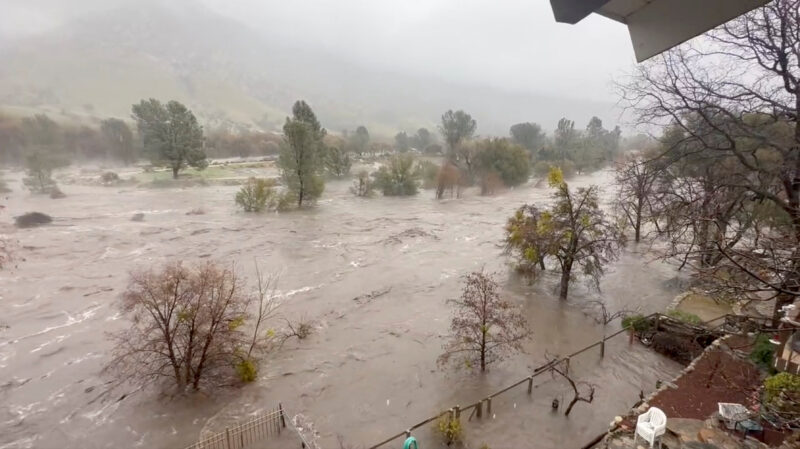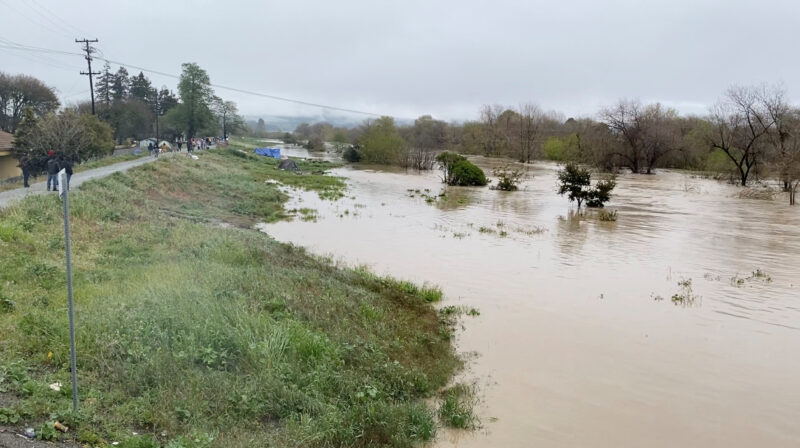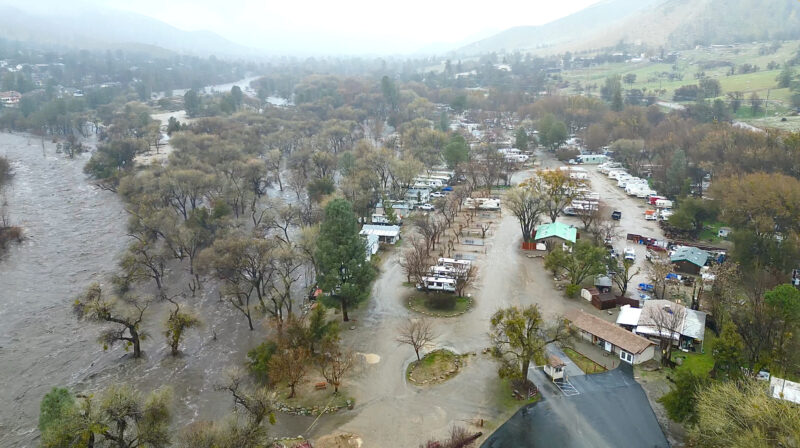LOS ANGELES (Reuters) – Emergency officials in several California counties spent Friday patrolling levies and swollen rivers as an “atmospheric river” storm drenched the already-sodden state with torrential rains, causing floods that washed out roads and prompted evacuations.
The latest deluge from dense streams of Pacific moisture sweeping California’s skies soaked some mountain areas still clogged with piles of snow dumped by a recent spate of paralyzing blizzards, while bringing even more snow to higher elevations.
The San Bernardino County Sheriff’s Department said it was investigating what role, if any, late-February snowstorms may have played in the demise of at least eight people, most of them elderly, found to have died alone while snowbound in their homes over the past two weeks.
Residents in the town of Big Bear and nearby mountain enclaves have said their communities were ill-prepared for the severity of winter storms that local authorities called unprecedented for Southern California’s high country.

The latest blast of heavy showers and gusty winds arrived Thursday night and peaked early Friday, sweeping a vast region that is home to some 26 million people, including greater Los Angeles, the San Francisco Bay area and metropolitan Sacramento.
Flood watches and advisories extended from San Diego and Mexican border to the Shasta-Cascade region of northern California.
The National Weather Service (NWS) reported rainfall totals ranging from 3 inches to nearly 10 inches across the region.
U.S. President Joe Biden on Friday declared an emergency in California, ordering federal assistance to help state and local authorities cope with the severe weather.
The storm was the product of what meteorologists call an atmospheric river, a high-altitude current of dense, subtropical moisture streaming into the West Coast from the warm Pacific waters around Hawaii.

It marks the 10th such weather system to hit California since Christmas, adding to an exceptionally wet, snowy winter in a state that in recent years has been plagued far more by drought and wildfires than by severe precipitation.
Among areas hardest hit on Friday were riverfront communities in central California where numerous streams engorged by runoff of rain and melting snow from surrounding mountains were transformed into raging torrents.
‘FULLY SATURATED’
About 2,000 residents were under evacuation orders and warnings in San Luis Obispo County, as crews there spent the day monitoring levees, creeks and rivers and filling sandbags, said Rachel Monte Dion, the county’s emergency services coordinator.
Some personnel spent hours in trailers watching for flooding in low-lying areas across the county, which was pummeled by heavy downpours in January, causing a levy to fail and damaging homes.
“Since January, it’s been raining steadily here and so our ground is fully saturated and our creeks are full,” Dion said, adding that flooding on Friday struck parts of the coastal wine country town of Cambria and the beachfront community of Oceano.
The collapse of one roadway in Paso Robles for the second time since January left a couple hundred residents outside that town cut off again, Dion said.
In Santa Cruz County, another road washed out by a flooded creek near the town of Soquel left at least 400 homes in adjacent foothill and mountain communities isolated, county spokesperson Jason Hoppin said.
Elsewhere in the county, communities along the swiftly rising San Lorenzo River were ordered evacuated before it reached flood stage, then receded, Hoppin said. Authorities were still keeping their eye on the Pajaro River, which drains a much larger area and thus takes longer to rise and fall, he said.
Evacuation orders were issued along the Monterey County banks of that river, where “the levee is a little bit lower” than on the Santa Cruz County side, Hoppin said.
On Friday morning, the weather service issued a flash-flood warning for parts of Tulare County, urging residents: “Move to higher ground now! This is an extremely dangerous and life-threatening situation.”
The Tulare County sheriff has issued evacuation orders and warnings for several areas where rivers and streams had either overrun their banks, were nearing dangerously high levels or where a levee was breached. At least one bridge was reported washed out.
The growing frequency and intensity of such storms amid bouts of prolonged drought are symptomatic of human-caused climate change, experts say. The swing from one extreme to another has increased the difficulty of managing California’s precious water supplies while minimizing flood and wildfire risks.
(Reporting by Steve Gorman in Los Angeles and Brendan O’Brien in Chicago)

